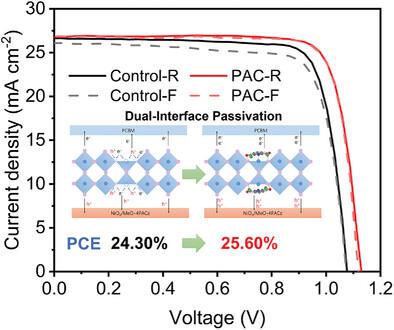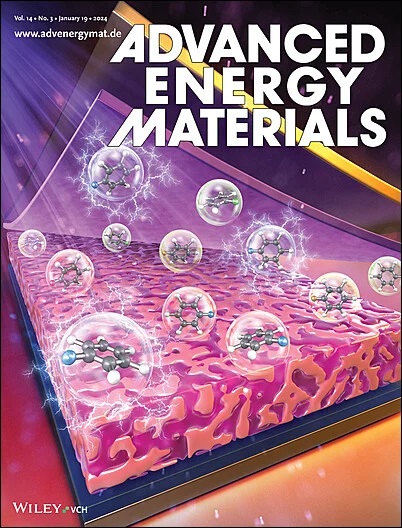Dual Interface Passivation With Multi-Site Regulation Toward Efficient and Stable Inverted Perovskite Solar Cells
IF 24.4
1区 材料科学
Q1 CHEMISTRY, PHYSICAL
引用次数: 0
Abstract
The rapid crystallization process of perovskite produces a large number of defects that remain a critical factor that disturbs the performance of perovskite solar cells (PSCs). In this research, these challenges are mitigated by introducing multifunctional 2,6-pyridinedicarboxylic acid chloride (PAC) as an additive into perovskite. During the thermal annealing process, the predominant accumulation of PAC occurs at the upper and buried interfaces of perovskite film. PAC possesses multiple passivating sites that facilitate the anchoring of lead and iodine defects, thereby enhancing the quality of the perovskite material across both its dual interfaces and grain boundaries. With this unique property, combined with the advantages of enhanced crystallization, reduced non-radiative recombination, boosted charge carrier mobility, and optimal energy level alignment, the PSC achieved a power conversion efficiency (PCE) of 25.60% and maintained more than 90% efficiency after 3000 h under one solar equivalent light and more than 90% efficiency after 1400 h under dark and high temperature (85 °C). The dual interface passivation strategy provides a sustainable solution to both stability and environmental challenges for the commercialization of perovskite solar cells.

求助全文
约1分钟内获得全文
求助全文
来源期刊

Advanced Energy Materials
CHEMISTRY, PHYSICAL-ENERGY & FUELS
CiteScore
41.90
自引率
4.00%
发文量
889
审稿时长
1.4 months
期刊介绍:
Established in 2011, Advanced Energy Materials is an international, interdisciplinary, English-language journal that focuses on materials used in energy harvesting, conversion, and storage. It is regarded as a top-quality journal alongside Advanced Materials, Advanced Functional Materials, and Small.
With a 2022 Impact Factor of 27.8, Advanced Energy Materials is considered a prime source for the best energy-related research. The journal covers a wide range of topics in energy-related research, including organic and inorganic photovoltaics, batteries and supercapacitors, fuel cells, hydrogen generation and storage, thermoelectrics, water splitting and photocatalysis, solar fuels and thermosolar power, magnetocalorics, and piezoelectronics.
The readership of Advanced Energy Materials includes materials scientists, chemists, physicists, and engineers in both academia and industry. The journal is indexed in various databases and collections, such as Advanced Technologies & Aerospace Database, FIZ Karlsruhe, INSPEC (IET), Science Citation Index Expanded, Technology Collection, and Web of Science, among others.
 求助内容:
求助内容: 应助结果提醒方式:
应助结果提醒方式:


